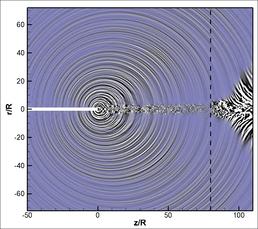Jet noise
- Started
- 1st October 2009
- Ended
- 17th December 2014
- Research Team
- Neil Sandham
- Investigators
- Richard Sandberg
Aero-engine manufactures have so far been able to considerably reduce jet noise by increasing bypass ratios. Further progress on noise reduction now depends on a detailed understanding of the exact noise generation mechanisms. It is widely recognised that both large-scale structures and fine-scale turbulence contribute to the overall sound radiated from subsonic jets and that here is an additional noise source associated with the flow separation over the sharp corner that occurs in the region near the nozzle exit. However, previous simulations of jet noise have not been able to include all possible noise generation mechanisms. In the current project the recent increase in computing power will be exploited to perform DNS of fully turbulent high subsonic Mach number jets that include the nozzle using a computational domain large enough to directly compute part of the far-field sound. With such a direct simulation approach all possible noise generation mechanisms will be included.
Categories
Physical Systems and Engineering simulation: Acoustics, CFD
Algorithms and computational methods: FFT, Finite differences
Simulation software: HiPSTAR
Visualisation and data handling software: TecPlot, Xmgrace
Software Engineering Tools: CVS, SVN
Programming languages and libraries: Fortran, MPI
Computational platforms: HECToR, Iridis
Transdisciplinary tags: HPC, Scientific Computing
